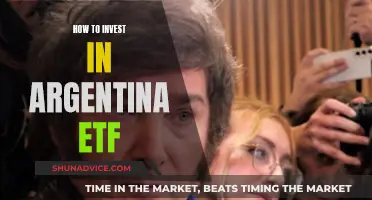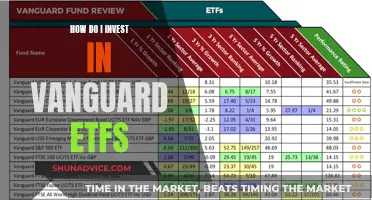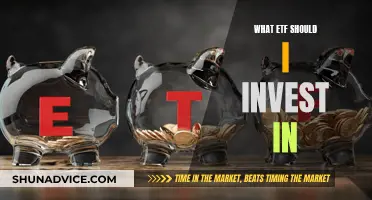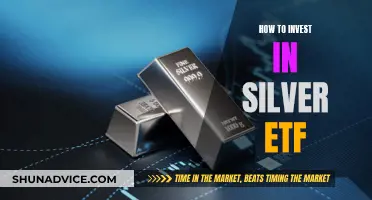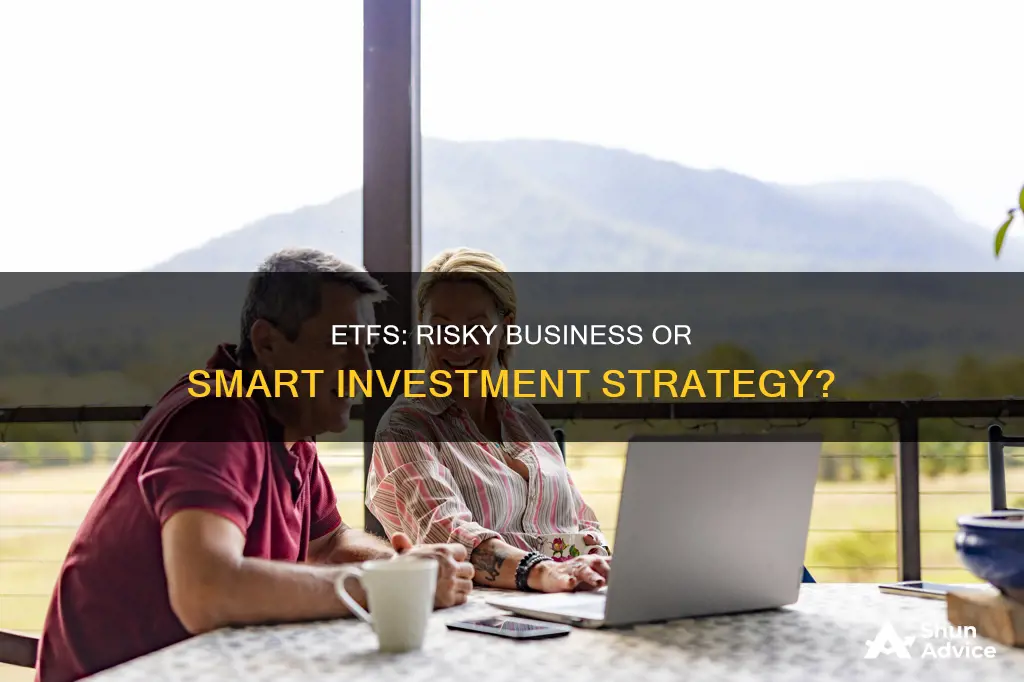
Exchange-traded funds (ETFs) are a popular investment option, but they are not without their drawbacks. While ETFs can be a good alternative to mutual funds, they are not a universally preferable solution. Here are some reasons why investors might choose not to invest in ETFs:
- Complexity: While ETFs appear simpler than traditional funds, some can be overly complex and gangly in what they actually own. For example, an oil ETF is likely to hold oil futures rather than the physical commodity, which has led to historical underperformance relative to oil prices.
- Temptation to trade: The wide variety of ETFs available can tempt investors to speculate, turning the investing process into more of a table game than a discipline.
- Human factor: ETFs make it almost impossible for a manager to add value, whereas mutual fund managers have more flexibility to load on factors such as beta, size, value, and momentum.
- International limits: International ETFs do exist, but options are limited compared to those in the US, especially for small-cap ETFs specific to a single country.
- Trading volume: Most ETFs are quite light in trading volume, and the bid-ask spread of a low-volume ETF can be too wide to be cost-effective for some investors.
- Low volatility: ETFs have less volatility on a day-to-day basis due to their diversified holdings, but this may not be desirable for short-term trades, where investors want to turn over assets quickly for profit.
- Risk: Some ETFs contain risky components that might not be obvious upfront, such as derivatives and other complex securities.
- Fees: While ETFs often have lower fees than mutual funds, they are not free. Investors may have to pay broker fees, and fund managers incur expenses covered by expense ratios, which can impact total returns.
- Tracking errors: ETFs may stray from their intended benchmarks, resulting in tracking errors where the ETF costs more than its underlying assets, and investors pay a premium.
- Less diversification: While ETFs generally offer high diversification, some are more narrowly focused on a particular sector, country, industry, or commodity, increasing risk.
- Liquidity: ETFs with low trading volume or high volatility may be difficult to sell, and investors might not get the price they expect.
- Capital gains distributions: ETFs that include dividend-paying stocks or sell assets at a profit can result in capital gains distributions, with associated taxes for shareholders.
- Lower dividend yield: ETFs tend to have lower yields than individual stocks, and investors may receive higher dividends by taking on the risk of owning individual stocks.
- Less control: Investors have less control over their individual investments in ETFs, as a professional selects the assets that make up the fund.
| Characteristics | Values |
|---|---|
| Fees | Some ETFs have no trading fees, but this depends on the ETF sponsor, brokerage or platform used to trade the fund. |
| Liquidity | ETFs with low trading volume may have a wide bid-ask spread, making it difficult for investors to sell. |
| Diversification | ETFs are designed to offer increased diversification, but some are more narrowly focused on a particular sector or subset of an asset class. |
| Volatility | ETFs have lower volatility than individual stocks, which may be a disadvantage for short-term trades. |
| Control | Investors have less control over their individual investments in an ETF as a professional selects the assets that make up the fund. |
| Tax efficiency | ETFs are usually more tax-efficient than mutual funds, but they are not always optimised for taxes. |
| Trading | ETFs are traded on exchanges throughout the day, similar to stocks. |
| Investment mixes | Investment mixes may be limited, and it can be harder to pick investments or investment mixes. |
| Partial shares | Depending on the brokerage firm, partial shares of ETFs may not be available. |
What You'll Learn

ETFs have fees
Exchange-traded funds (ETFs) are not free – they have fees. While ETFs are often marketed as a low-cost investment option, investors should be aware of the various costs involved when investing in them. The most significant fee is the operating expense ratio (OER), which is an annual rate charged by the fund on the total assets it holds to cover portfolio management, administration, and other costs. This fee is relevant for all investors, especially those who plan to hold the ETF for the long term. The OER can vary significantly across different ETFs, with the lowest-cost ETFs having expense ratios of less than 0.10% and the highest-cost ETFs exceeding 10%. Actively managed ETFs tend to have higher OERs than passively managed ones.
In addition to the OER, investors may also have to pay commissions when buying or selling ETFs. These commissions can vary depending on the brokerage firm and the size of the trade. Some firms, like Charles Schwab, offer commission-free ETF trading for certain funds. It is important to note that the impact of commissions is more significant for smaller investments and more frequent trades.
Another cost to consider is the bid/ask spread, which is the difference between the highest price a buyer is willing to pay for a share (bid price) and the lowest price a seller is willing to accept (ask price). The bid/ask spread can vary between ETFs and tends to be larger for those with low trading volume. This cost is particularly important for investors who plan to hold the ETF for less than a year.
ETFs may also have hidden or indirect costs. For example, ETFs that invest in other ETFs or mutual funds (known as fund-of-funds) tend to have higher expense ratios as they reflect the fees of the underlying investments. Additionally, investors should be aware of changes in discounts and premiums to the net asset value (NAV) of the ETF, which can impact overall returns.
While ETFs generally have lower fees than comparable mutual funds, it is crucial for investors to carefully examine the relative costs of different investment options. Savvy investors can avoid some ETF fees by managing stocks on their own or opting for no-load mutual funds, which do not charge sales loads.
Invest in ETF MJ: A Guide to Getting Started
You may want to see also

ETFs may not reflect the value of the underlying asset
Exchange-traded funds (ETFs) are a popular investment vehicle that pools money from investors to buy a diverse basket of stocks, bonds, and other securities. While ETFs offer several advantages, such as tax benefits, lower fees, and trading versatility, they also have certain drawbacks. One notable disadvantage is that ETFs may not always accurately reflect the value of their underlying assets. Here are some reasons why ETFs may deviate from the value of their underlying holdings:
Time Zone Differences and Market Operations: ETFs investing in international stocks may not update their net asset value (NAV) in real time due to time zone differences. If the underlying markets in other countries are closed, the NAV may be outdated. In such cases, the ETF's share price may be determined by investor demand, resulting in a premium or discount compared to the actual value of the underlying assets.
Supply and Demand: The market price of an ETF can deviate from its NAV due to supply and demand factors. If there is a high demand for a particular ETF, its market price may be higher than its NAV, leading to a premium. Conversely, if there is a sudden rush to sell shares of the ETF, its market price may dip below the NAV, resulting in a discount.
Trading Volume: Most ETFs have relatively low trading volumes compared to large index ETFs. The bid-ask spread of a low-volume ETF can be too wide to be cost-effective for some investors. As a result, the market price of the ETF may not accurately reflect the value of its underlying assets.
Tracking Disparities: ETFs that track indexes may not perfectly emulate the returns of the index. This can occur when the ETF does not hold all the stocks in the index or when the weightings of the stocks in the ETF differ from those in the index. Additionally, the costs of buying and selling the underlying shares can affect the ETF's performance relative to the index.
Authorized Participants and Arbitrage: Specialized investors called "authorized participants" can create or redeem ETF shares by exchanging the underlying holdings. They profit from arbitrage opportunities when the value of the ETF deviates from the value of its underlying assets. While this mechanism usually keeps prices aligned, it can also lead to scenarios where unexpected trading volumes influence values in the opposite direction.
In conclusion, while ETFs offer numerous benefits, investors should be aware that the market price of an ETF may not always accurately reflect the value of its underlying assets due to various factors, including time zone differences, supply and demand, trading volumes, tracking disparities, and the activities of authorized participants.
ETF Investing: What You Need to Know
You may want to see also

ETFs are not always tax-efficient
While ETFs are generally considered tax-efficient, they are not always so. Here are some reasons why:
ETFs and Taxes
Although ETFs are often marketed as tax-efficient, this efficiency is not guaranteed and depends on various factors. ETFs can have tax consequences, and it's important to understand how they are taxed and how their structure can help minimise taxes. Taxes on ETF distributions can come from multiple sources, such as dividends from underlying stock holdings, interest generated by underlying fixed-income holdings, and capital gains generated when the fund manager buys and sells securities.
Tax Efficiency Compared to Mutual Funds
ETFs are typically more tax-efficient than mutual funds due to their unique in-kind creation and redemption process, which helps avoid realising capital gains. Additionally, ETFs usually have lower turnover rates and distribute fewer capital gains than mutual funds. However, the fund's structure can significantly impact its tax efficiency, and certain types of ETFs, such as those backed by physical metals or using futures contracts, may be subject to different tax treatments.
International ETFs
International ETFs exist, but the options are more limited compared to those available for US market sectors. Most foreign ETFs consist of large-cap companies spread across multiple countries, and it can be challenging to find small-cap ETFs specific to a single country, especially for smaller economies.
Complexity
Some ETFs can be complex, and it's important to carefully research the goals, underlying index, and holdings before investing. Certain ETFs contain risky components or derivatives that may not be immediately obvious. For example, buying an oil ETF because you believe the price of oil will increase may result in disappointment if the ETF holds oil futures rather than the physical commodity, leading to potential underperformance relative to the oil price.
Trading Costs
While ETFs often have lower fees and costs compared to mutual funds, they are not free. There are still management fees to consider, and for frequent trading, the costs can add up. It's important to be mindful of the potential impact of trading costs on the overall returns of an ETF investment.
A Beginner's Guide to Australian ETF Investing
You may want to see also

ETFs come with risk
Like any investment, ETFs come with risks that should be carefully considered before making any trades.
Fees and Costs
Firstly, ETFs are not free. While they are generally cheaper than other lower-risk investment options, such as mutual funds, there are still fees to consider. Investors may have to pay a broker to facilitate the trade, and these fees can range from $8 to $30 and are paid every time an investor buys or sells shares in a fund. ETFs also have expense ratios, which cover the fund's normal business operations, such as employee salaries and marketing costs. As of 2020, ETF expense ratios were usually less than 0.5%.
Liquidity
Liquidity refers to how easily an investor can buy or sell a security in a secondary market. If an ETF trades at low volume or high volatility, an investor may struggle to sell it. Many investors are concerned about the liquidity of ETFs, especially during significant market volatility.
Tracking Errors
An ETF manager will try to keep the fund's performance aligned with the index it tracks, but this can be challenging. If the fund manager needs to swap out assets, for example, the ETF may not reflect the holdings of the index, and its performance may deviate. This can lead to tracking errors, which is when an ETF costs more than its underlying assets, and an investor pays a premium.
Volatility and Risk
ETFs are affected by the volatility of the market, and some ETFs contain riskier securities that may not be obvious to the investor.
Tax Implications
Although ETFs are considered more tax-efficient than mutual funds, they are not always optimised for taxes. Shareholders are responsible for paying taxes associated with capital gains distributions and dividend-paying stocks.
ETFs: Niche Strategies or Broad Investment Focus?
You may want to see also

ETFs may not be suitable for short-term trades
Exchange-traded funds (ETFs) are not always suitable for short-term trades due to several factors, including complexity, volatility, trading costs, and liquidity.
Firstly, the complexity of some ETFs can make them less suitable for short-term trading. Some ETFs are actively traded, but most are quite light in trading volume. This means that for short-term trades, there may not be enough trading interest to allow investors to get out of the investment quickly without impacting the price. Additionally, the bid-ask spread of a low-volume ETF can be too wide to be cost-effective for short-term trades.
Secondly, ETFs tend to have lower volatility compared to individual stocks, as they are a package of diversified holdings. This low volatility means that the equity is less likely to experience significant price movements over a short period, reducing the potential for quick profits in short-term trades.
Thirdly, the trading costs associated with ETFs can impact the profitability of short-term trades. While ETFs generally have lower fees and costs compared to mutual funds, they are not free. There are expense ratios and fund management fees to consider, and these costs can quickly add up if the ETF is actively traded.
Finally, liquidity is an important consideration for short-term trades, and not all ETFs offer high liquidity. Traders should avoid ETFs with a high percentage of off-exchange trades, as they can lead to a lack of liquidity on the exchange. Additionally, ETFs with illiquid underlying assets, such as bonds or a limited number of underlying stocks, may not provide the necessary liquidity for short-term trading.
In conclusion, while ETFs offer benefits such as diversification and tax efficiency, they may not always be suitable for short-term trades due to complexity, low volatility, trading costs, and liquidity concerns. Investors should carefully consider these factors before utilizing ETFs for short-term trading strategies.
A Beginner's Guide to ETF Investing with TD Ameritrade
You may want to see also
Frequently asked questions
ETFs are not always a good investment option as they have several disadvantages. Firstly, they have costs and fees associated with them, including expense ratios, trading fees, and broker fees. Secondly, ETFs may not provide the desired level of diversification as some are more narrowly focused on specific sectors, countries, or industries. Finally, ETFs are designed to track the market rather than beat it, so they may not provide the level of returns desired by investors looking for higher risk and reward.
One alternative to ETFs is investing in mutual funds, which are actively managed and may provide the potential to outperform the market. Mutual funds also allow for partial shares and provide more control over individual investments as investors select the assets that make up the fund. Additionally, individual stocks and bonds can be purchased, requiring more research and time commitment but offering more flexibility and the potential for higher returns.
ETFs carry various risks, including tracking errors, liquidity issues, and capital gains distributions. Tracking errors occur when an ETF deviates from its intended benchmarks, resulting in potential costs higher than the underlying assets. Liquidity issues may arise due to low trading volume, making it challenging for investors to sell their ETFs. Capital gains distributions can lead to tax obligations for shareholders, impacting overall returns.



